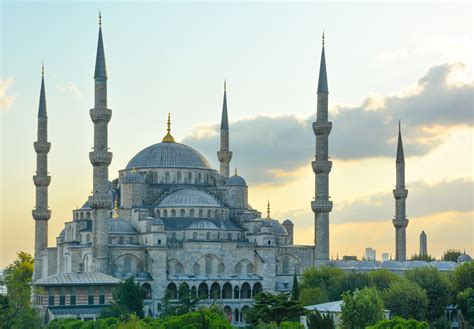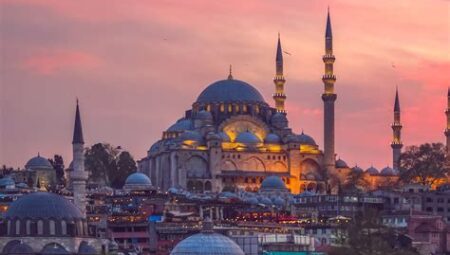Explore the historical and architectural significance of Istanbul’s Blue Mosque, its role in cultural integration, tourism, and influence on modern Islamic architecture.The Blue Mosque, or Sultan Ahmed Mosque, stands as a dazzling emblem of Istanbul’s rich cultural tapestry, intertwining history, architecture, and spirituality. This remarkable structure not only symbolizes the city’s Islamic heritage but also showcases the intricate relationship between faith and societal development. As we explore its historical significance, architectural brilliance, and role as a beacon of cultural integration, we uncover the profound impact this iconic landmark has had on Istanbul’s evolving identity. Furthermore, we’ll delve into the mosque’s contribution to tourism and economic progress, affirming its status as a vital element in both Istanbul’s past and its modern-day allure. Join us in examining how the Blue Mosque continues to shape not only the skyline of Istanbul but also the hearts and minds of those who visit.
Historical Significance of the Blue Mosque in Istanbul’s Development
The Blue Mosque, officially known as the Sultan Ahmed Mosque, stands as a significant landmark in Istanbul, embodying the city’s rich history and cultural evolution. Built between 1609 and 1616 during the reign of Sultan Ahmed I, this architectural marvel not only served as a place of worship but also played a pivotal role in the sociopolitical landscape of the Ottoman Empire.
Its construction marked a period of both religious devotion and artistic ambition, as the mosque was designed to rival the grandeur of the famed Hagia Sophia. In doing so, it symbolized the triumph of modern Islamic architecture and the continuing development of the empire’s cultural identity. The Blue Mosque’s innovative use of space and light, with its sweeping domes and expansive courtyards, influenced subsequent mosque designs both within and beyond the borders of Turkey.
Furthermore, the mosque consolidated the area surrounding it as a central spiritual and administrative hub, boosting Istanbul’s significance as a cultural crossroads between East and West. It encouraged the establishment of social services, such as schools and caravanserais, fostering a thriving community that contributed to the urban fabric of the city.
As a result, the Blue Mosque not only shaped the architectural heritage of Istanbul but also became a vital symbol during various historical events, reinforcing national identity amidst periods of change. Today, it remains a key attraction, reminding both locals and visitors of Istanbul’s complex past and its enduring status as a center for modern Islamic architecture.
Architectural Features Reflecting Modern Islamic Architecture Principles
The Blue Mosque, also known as the Sultan Ahmed Mosque, is a remarkable example of how modern Islamic architecture integrates historical elements while introducing innovative designs that resonate with contemporary aesthetics. The mosque’s grand scale and harmonious proportions reflect the classic principles of Islamic architecture, yet its features set the stage for modern interpretations.
One of the most striking aspects of the Blue Mosque is its impressive dome, which is both a nod to traditional Byzantine architecture and a pioneer of modern design techniques. The large central dome is complemented by several smaller domes and semi-domes, creating a visually appealing silhouette that accentuates the mosque’s towering minarets. This feature exemplifies how modern Islamic architecture employs geometric forms to achieve both beauty and structural integrity.
Additionally, the use of light plays a significant role in the mosque’s interior design. The strategically placed windows allow natural light to fill the prayer hall, illuminating intricate tilework and calligraphy. This blending of illumination with artistry is a hallmark of modern Islamic architecture, illustrating a spiritual connection through visual experience.
Another notable feature is the mosque’s spaciousness, allowing for a vast congregation area that reflects a modern understanding of communal worship. The open floor plan encourages inclusivity and accessibility, aligning with the principles of contemporary spirituality in Islamic architecture.
The incorporation of contemporary materials alongside traditional ones demonstrates a flexibility in design that characterizes modern Islamic architecture. The Blue Mosque successfully merges historical significance with innovative advancements, inspiring architects and designers around the world to explore new possibilities within the rich tradition of Islamic architecture.
Cultural Integration: The Blue Mosque’s Role in Istanbul’s Identity
The Blue Mosque, or Sultan Ahmed Mosque, is not just an architectural masterpiece; it is a vital element in the cultural tapestry of Istanbul. Its significance extends beyond religious functions to embody a unique blend of traditions, fostering a sense of unity among the diverse populations of the city. The mosque serves as a gathering place for various cultural events, weddings, and community celebrations, thus reinforcing its position as a hub of social interaction.
As a visual representation of Modern Islamic architecture, the Blue Mosque transcends mere structure. It invites both locals and tourists alike, symbolizing a shared heritage while also reflecting the evolution of Islamic design principles. Its grandeur and beauty promote cultural pride among the citizens of Istanbul, contributing to their collective identity and sense of belonging.
Moreover, the mosque’s accessibility has encouraged cultural exchange, allowing visitors from different backgrounds to experience the rich history and traditions of Istanbul. Educational initiatives and guided tours have increased awareness of its architectural innovations, which further highlights the importance of the Blue Mosque in fostering understanding and appreciation between diverse communities.
The Blue Mosque stands as a testament to Istanbul’s dual legacy of religious devotion and artistic excellence. It embodies the city’s ability to cultivate a harmonious existence among its residents, making it a true cornerstone of Istanbul’s identity.
The Blue Mosque as a Symbol of Religious and Cultural Harmony
The Blue Mosque, officially known as the Sultan Ahmed Mosque, stands as a powerful emblem of religious and cultural harmony in Istanbul. Its architectural grandeur and spiritual ambiance draw not only worshippers but also visitors from all over the world, fostering a deep appreciation for both Islamic heritage and the broader cultural tapestry of the city.
This magnificent structure, with its striking blue tiles and vast prayer hall, serves as a reminder of Istanbul’s unique position as a bridge between East and West. The mosque’s design reflects a harmonious blend of Islamic and Byzantine architectural elements, showcasing the ability of diverse cultures to coexist and enrich one another. As a result, it attracts individuals of varying backgrounds, encouraging dialogue and understanding among different faiths and ethnicities.
In recent years, the Blue Mosque has also taken on an added role as a symbol of peace, especially in the wake of global tensions regarding religion. Its open doors welcome all, emphasizing the message that places of worship can be sites of common ground rather than division. As a continuous function of the mosque within the life of Istanbul’s citizens, it acts as a focal point for both communal gatherings and individual reflection.
Furthermore, the mosque’s role in promoting cultural exchange cannot be understated. Educational tours, interfaith dialogues, and cultural events often take place within its walls, thereby strengthening the bond between locals and tourists. In this way, the Blue Mosque not only stands as a testament to modern Islamic architecture but also as a lasting symbol of unity and harmony in an increasingly fragmented world.
Tourism and Economic Growth Driven by the Blue Mosque’s Popularity
The Blue Mosque, known as Sultan Ahmed Mosque, serves as a pivotal landmark in Istanbul, attracting millions of visitors each year. Its awe-inspiring architecture and rich history contribute significantly to the city’s tourism appeal. The influx of tourists not only elevates the cultural status of Istanbul but also plays a crucial role in driving the local economy.
As one of the most recognized examples of Modern Islamic architecture, the Blue Mosque stands as a testament to the artistic and spiritual heritage of the region. Visitors from around the world come to admire its majestic domes, elegant minarets, and intricate tile work, bolstering the tourism sector in Istanbul. These tourists often spend on various services, including guided tours, local accommodations, dining, and shopping, providing a considerable boost to the city’s economy.
Moreover, the Blue Mosque’s prominence in tourism has spurred growth in related sectors, such as hospitality, transportation, and retail. Hotels and restaurants surrounding the mosque have thrived, providing jobs and stimulating economic development. Additionally, craft markets and souvenir shops benefit from the steady stream of visitors eager to take a piece of Istanbul home with them.
Events and cultural programs hosted at or around the mosque also enrich the tourist experience, creating more opportunities for engagement with Istanbul’s heritage. Such initiatives not only promote the Blue Mosque and its significance but also foster a deeper connection between visitors and the local culture.
The Blue Mosque is not merely an architectural marvel; it is a vital economic engine that drives tourism and contributes to the cultural richness and identity of Istanbul. The ongoing interest in Modern Islamic architecture is expected to enhance these trends, ensuring that the mosque remains a central figure in both the historical and contemporary landscape of the city.
The Influence of the Blue Mosque on Modern Islamic Architecture Trends
The Blue Mosque, officially known as the Sultan Ahmed Mosque, stands as an iconic representation of Modern Islamic architecture. Its unique blend of traditional and contemporary design elements has inspired countless architects and designers across the globe. As a pivotal example of Ottoman architecture, the mosque not only reflects the cultural heritage of Istanbul but also contributes to the evolving dimensions of Islamic architectural identity.
One of the most influential aspects of the Blue Mosque is its innovative use of space and light. The vast central dome, coupled with semi-domes and surrounding arches, creates an awe-inspiring interior that is both functional and aesthetically pleasing. This emphasis on spatial harmony has been echoed in various modern Islamic structures, where the use of open spaces continues to prioritize community and spiritual engagement.
Moreover, the mosque’s intricate tile work and calligraphy resonate in contemporary buildings that seek to preserve Islamic artistic traditions while integrating modern materials and techniques. As architects embrace Modern Islamic architecture, they often draw inspiration from the Blue Mosque’s decorative motifs, demonstrating how historical forms can adapt to meet current design trends.
The Blue Mosque also serves as a reminder of the importance of cultural narratives in architecture. Its design was not merely an architectural endeavor but a symbol of a burgeoning Islamic identity during the Ottoman Empire. This duality—functionality rooted in a strong cultural context—inspires modern architects to create spaces that are both innovative and reflective of their cultural backgrounds.
The Blue Mosque’s profound influence on Modern Islamic architecture continues to inspire architects worldwide. Its timeless designs demonstrate that tradition and modernity can coexist, paving the way for the future of Islamic architectural expression.
Frequently Asked Questions
What is the significance of the Blue Mosque in Istanbul?
The Blue Mosque, or Sultan Ahmed Mosque, is a symbol of Istanbul’s architectural brilliance and cultural heritage, representing the city’s historical significance in both Islamic and Ottoman culture.
How does the Blue Mosque influence tourism in Istanbul?
As one of the most visited landmarks, the Blue Mosque attracts millions of tourists each year, playing a critical role in Istanbul’s economy and promoting cultural exchange.
What architectural features make the Blue Mosque unique?
The Blue Mosque is renowned for its stunning blue Iznik tiles, grand dome, and six minarets, combining Byzantine and Ottoman architectural elements that create a unique visual experience.
How has the Blue Mosque shaped the spiritual life of Istanbul’s residents?
The Blue Mosque serves as a major place of worship, fostering community gatherings and spiritual practices for locals, thus reinforcing Islamic traditions in Istanbul.
What role does the Blue Mosque play in Istanbul’s cultural identity?
The Blue Mosque embodies a blend of history, religion, and art, reinforcing Istanbul’s identity as a crossroads of cultures and a significant center of Islamic influence.
What are some of the challenges facing the Blue Mosque today?
Challenges include maintaining its structural integrity amidst pollution and tourism pressures, as well as balancing the needs of worshippers with the demands of visitors.
How does the Blue Mosque contribute to the dialogue between different cultures?
The Blue Mosque acts as a cultural bridge by inviting people from various backgrounds to appreciate its beauty, fostering dialogue and understanding among diverse groups of visitors.




